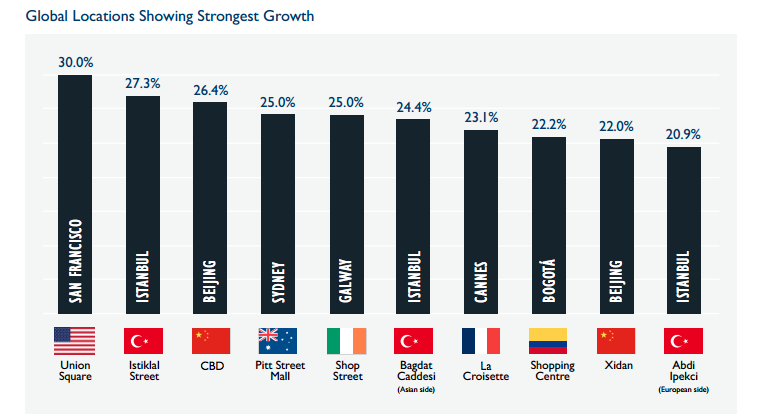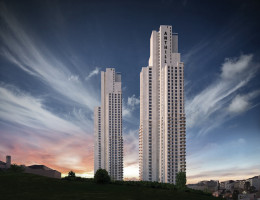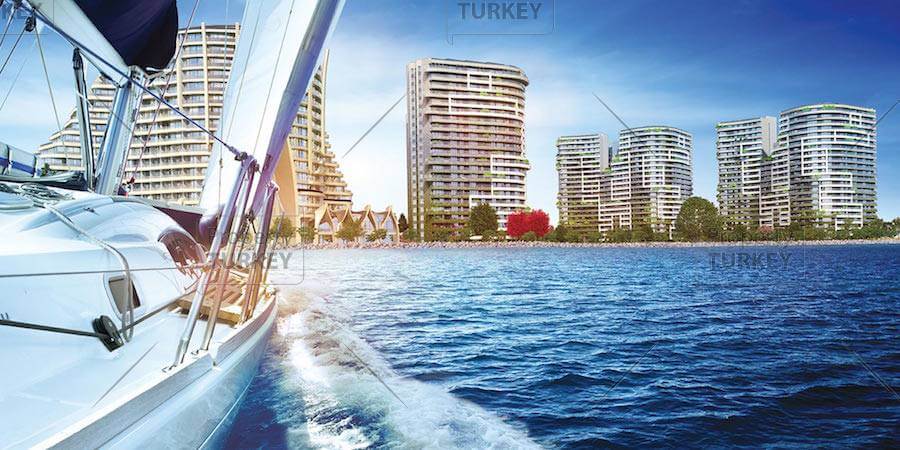Istanbul’s famous Istiklal, Bagdat and Abdi Ipekci avenues are ranked in the top 10 streets for rental increase in Europe, according to new figures released by an international real estate consultancy firm.
Cushman & Wakefield’s “Istanbul’s Shopping Streets” report analysed transaction volume and rental increase on the three streets. According to the report, there were 17,500 square metres of rental property rented out over these three streets in the past year.
Rents on Istiklal Avenue and Abdi Ipekci, both on the European side of the city, increased by 27.3 percent and 20.9 percent respectively. On the Asian side, Bagdat Avenue saw an increase of 24.4 percent.

Hotel investments also took a leap, with 275 hotels sold in 57 municipalities, bringing the total number of available hotel beds to 73,000.
Almost one in five people out of Turkey’s 77-million strong population now resides in Istanbul. This economic, cultural and historic powerhouse is undoubtedly the heart of the country - and its expanding population needs housing more than ever before.
Cameron Deggin of propertyturkey.com explains. “Istanbul is expanding at a faster rate than other Turkish centres, which is why rents have increased so much.” There are two categories of people looking to buy Istanbul property, the Turkish property expert says: ordinary residents working in the city, and investors.
Deggin says new developments targeted specifically at commuters are being built on the city’s outskirts, where there is plenty of space - and a lot of demand - for such projects. However, in the city centre - where the big three streets mentioned above are located - there is little scope for new development.
“This is some of the most sought-after property in the world, and despite prices rising very sharply over the last decade demand just isn’t slowing, making Istanbul one of the world’s best options for investment and rental property.”

Istiklal Avenue welcomes up to six million people on a typical weekend, making it one of the city’s most visited areas. The avenue is located in the historic Beyoglu district, and its history is writ large in the Ottoman era buildings that flank the street, striking for their Neo-Gothic, Art Nouveau and Renaissance Revival designs. Istiklal is a pedestrianised street with a passenger tram running its 1.4 kilometre length. Along Istiklal you’ll find boutique shops, music stores, galleries, cinemas, theatres, cafes, restaurants, chocolateries and night clubs.
During the Ottoman era, the street was called Cadde-i Kebir (Grand Avenue), and was the intellectual hub of Istanbul, attracting artists, philosophers and thinkers from all over the globe. When Turkey became a republic in 1923 the street was renamed Istiklal, which means independence.

Bagdat has an intriguing association with street racing. In the 1960s wealthy young men raced their imported cars. This sub-cuture activity lasted into the 1990s, when a number of fatal accidents resulted in a police crackdown.
Bagdat began life as a trade and military road that connected Constantinople with Anatolia during the Byzantine and Ottoman eras. Fountains (cesme) with prayer areas were erected along the route for travellers, and the names of these fountains live on in the districts along Bagdat, such as Selamicesme and Catalcesme.
During the reign of Sultan Abdul Hamid II in the late nineteenth century, Pashas, high officials and wealthy citizens built luxurious wooden chalet mansions along Bagdat, some of which are still around today and can be visited.
Bagdat is considered the centre for celebration on the Asian side of the city, and people gather here for big events like the Republic Day parade and sporting victories.

The street was named for Abdi Ipekci, a renowned left-wing journalist and editor of the large newspaper Milliyet. He was murdered in 1979 by a mercenary who later escaped prison and went on to shoot and wound Pope John Paul II.
Abdi Ipekci is a popular party spot, and is becoming known for its new year celebrations.

Cushman & Wakefield’s “Istanbul’s Shopping Streets” report analysed transaction volume and rental increase on the three streets. According to the report, there were 17,500 square metres of rental property rented out over these three streets in the past year.
Rents on Istiklal Avenue and Abdi Ipekci, both on the European side of the city, increased by 27.3 percent and 20.9 percent respectively. On the Asian side, Bagdat Avenue saw an increase of 24.4 percent.

Over a million properties sold
Further Cushman & Wakefield data showed that 1.16 million Turkish properties were sold last year - and increase of 2 per cent on 2013. A third of these sales involved taking out a mortgage, and there was a 56 percent increase in Istanbul property sales to foreigners, who snapped up 18,959 properties.Hotel investments also took a leap, with 275 hotels sold in 57 municipalities, bringing the total number of available hotel beds to 73,000.
Spiralling hotel occupancy
Total visitor numbers to Turkey jumped by 5.5 percent from 2013, with 36.8 million people arriving last year. Istanbul attracted just under a third of this figure with 11.8 million visitors, an increase of 12 percent. However, the city’s hotel occupancy dropped by 35 percent, an indication of just how successful the Istanbul rental story has been. Visitors are now seeking more personal accommodation, and self catering rental accommodation is on the rise.Population boom
Rental increases are being driven by Istanbul’s increasing population. While this is a countrywide phenomenon, with an 0.5 percent increase in the number of city dwellers in 2014, nowhere is this more evident than in Istanbul.Almost one in five people out of Turkey’s 77-million strong population now resides in Istanbul. This economic, cultural and historic powerhouse is undoubtedly the heart of the country - and its expanding population needs housing more than ever before.
Cameron Deggin of propertyturkey.com explains. “Istanbul is expanding at a faster rate than other Turkish centres, which is why rents have increased so much.” There are two categories of people looking to buy Istanbul property, the Turkish property expert says: ordinary residents working in the city, and investors.
Deggin says new developments targeted specifically at commuters are being built on the city’s outskirts, where there is plenty of space - and a lot of demand - for such projects. However, in the city centre - where the big three streets mentioned above are located - there is little scope for new development.
“This is some of the most sought-after property in the world, and despite prices rising very sharply over the last decade demand just isn’t slowing, making Istanbul one of the world’s best options for investment and rental property.”

A guide to Istanbul’s Big Three
Istiklal Avenue
Istiklal Avenue welcomes up to six million people on a typical weekend, making it one of the city’s most visited areas. The avenue is located in the historic Beyoglu district, and its history is writ large in the Ottoman era buildings that flank the street, striking for their Neo-Gothic, Art Nouveau and Renaissance Revival designs. Istiklal is a pedestrianised street with a passenger tram running its 1.4 kilometre length. Along Istiklal you’ll find boutique shops, music stores, galleries, cinemas, theatres, cafes, restaurants, chocolateries and night clubs. During the Ottoman era, the street was called Cadde-i Kebir (Grand Avenue), and was the intellectual hub of Istanbul, attracting artists, philosophers and thinkers from all over the globe. When Turkey became a republic in 1923 the street was renamed Istiklal, which means independence.

Bagdat Avenue
Fourteen kilometre-long Bagdat Avenue runs from east to west in the Maltepe and Kadikoy districts on the Asian side of Istanbul, nearly parallel to the Sea of Marama coastline. The street is an upscale residential and shopping area, lined with plane trees and host to shopping malls, department stores, fashion shops and elegant brand shops. There’s a wealth of good restaurants, pubs and cafes.Bagdat has an intriguing association with street racing. In the 1960s wealthy young men raced their imported cars. This sub-cuture activity lasted into the 1990s, when a number of fatal accidents resulted in a police crackdown.
Bagdat began life as a trade and military road that connected Constantinople with Anatolia during the Byzantine and Ottoman eras. Fountains (cesme) with prayer areas were erected along the route for travellers, and the names of these fountains live on in the districts along Bagdat, such as Selamicesme and Catalcesme.
During the reign of Sultan Abdul Hamid II in the late nineteenth century, Pashas, high officials and wealthy citizens built luxurious wooden chalet mansions along Bagdat, some of which are still around today and can be visited.
Bagdat is considered the centre for celebration on the Asian side of the city, and people gather here for big events like the Republic Day parade and sporting victories.

Abdi Ipekci
One of Istanbul’s prime shopping streets, Abdi Ipekci is located in the Sisli district, running from Bayildim Caddesi to Vali Konagi Caddesi. Over the last decade the street has become one of the city’s premier spots for luxury retail shops. And with a monthly rental price of $3500, it’s also the most expensive street for retail stores in Turkey. Its exclusive - and very expensive - shops offer local and international designer brands. There are also a number of fittingly expensive restaurants and cafes along the street.The street was named for Abdi Ipekci, a renowned left-wing journalist and editor of the large newspaper Milliyet. He was murdered in 1979 by a mercenary who later escaped prison and went on to shoot and wound Pope John Paul II.
Abdi Ipekci is a popular party spot, and is becoming known for its new year celebrations.







